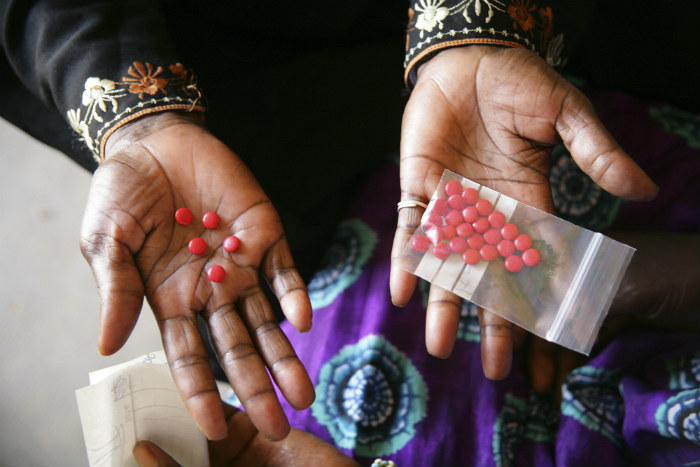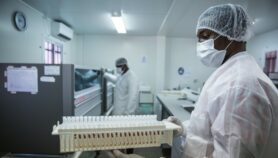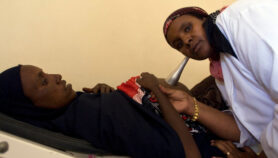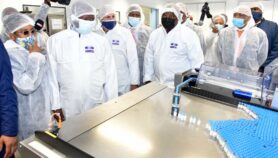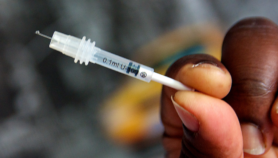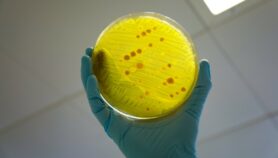By: Inga Vesper
Send to a friend
The details you provide on this page will not be used to send unsolicited email, and will not be sold to a 3rd party. See privacy policy.
What would you do with US$10 billion? Buy a tropical island and live the high life? Or use it to make the world a better place? Surely, that’s enough money to make a difference.
Think again. From a global viewpoint, US$10 billion is not much money. It’s about the price of a large nuclear power station. It’s the amount the International Monetary Fund paid out in March 2015 to bail out Ukraine’s banks. It’s what member states of the UN Framework Convention on Climate Change collectively put every year into the Green Climate Fund.
Ten billion dollars is also the approximate cost of combating antibiotic resistance across the globe over the next decade, according to Kevin Outterson, who researches health law at the University of Boston, United States. Outterson joined with colleagues in February to call for the creation of an international legal framework to address the problem of increasing antimicrobial resistance. [1] According to their proposal, published in the Bulletin of the World Health Organization, this money would be enough to perform three vital steps to solve the problem: provide universal access to antimicrobial drugs, better administrate drug dispensing to reduce the misuse of antibiotics, and ramp up research across the world on finding better drugs.
International health bodies are pushing for action on the matter. On 25 May the WHO launched a set of resolutions to tackle antimicrobial resistance. These include strengthening surveillance and research, develop better medicine and alert those at the highest level of government to the problem.
Yet there is little awareness among policymakers and the general public of the scale of antimicrobial resistance — and that’s why the proposed US$10 billion is incredibly hard to find.
But the scale of the problem is frightening — antimicrobial resistance already kills around 700,000 people a year all over the world, according to medical research charity the Wellcome Trust. By 2050, this could hit ten million, the charity says, as resistance is rising rapidly, especially in the developed world.
While they are no less urgent, other global health crises such as Ebola and cholera look minor in comparison. Yet, as Outterson says: “You don’t see people in orange jumpsuits helping people who are dying [of antibiotic resistance]. Why did Ebola provoke this amazing response, but the potential destruction of the most important drug class in human history doesn’t? Why are we scraping for dollars?”
Three-pronged response
Part of the answer is that antimicrobial resistance is a multipronged problem. The drugs are vital to tackle bacterial infections, such as tuberculosis, pneumonia and typhus. But the problem is not just about drugs. A combination of ignorance around the world, even among doctors, and lax controls over medicine distribution mean antibiotics are often used to treat parasites, such as malaria, and viruses. Antibiotics are ineffective against these and deploying them wrongly allows bacteria to build resistance to them, rendering them useless. This problem is magnified by the difficulty of developing new antibiotics, as research leads are becoming scarcer and funding dries up.
Therefore restricting the inappropriate use of antibiotics everywhere — in animal farming as well as human medicine — is an important first step. There are fears, however, that this could devastate many poorer countries where access to these life-saving drugs is still a problem, and many die because antibiotics fail to reach those who need them in the first place. And according to Iruka Okeke, a biologist at Haverford College in the United States who studies antimicrobial resistance, improving access to antibiotics would actually address some of the issues around maladministration and treatment disruption.
“One of the reasons why people hoard antibiotics, for example from a previous prescription, is because they do not have assurance that they will be able to get them when they need them,” she says.
But controlling drug administration while improving access is only two-thirds of the battle — the last, and perhaps most important, part of the offensive is increasing research and innovation to find new drugs.
This is crucial, as the present spending pattern on antibiotics research looks alarming, even in rich countries. Over the last year, many health, scientific and government associations — including the WHO, the European Union, the UK’s Royal Society of Chemistry and the US National Institutes of Health — have urged policymakers to force drugs firms to step up antibiotic development. According to a UK government-commissioned review led by economist Jim O’Neill, the United States spent just US$1.7 billion on this in combined public and private funding between 2010 and 2014, compared with US$14.5 billion on HIV/AIDS and US$26.5 billion on cancer. [2] Only two new systemic antibiotics (drugs that affect the whole body) were approved in the United States between 2008 and 2012.
Incidentally, antimicrobial resistance costs the US health system almost exactly US$10 billion a year. So with new drugs, the United States alone could save every year the proposed entire ten-year cost of tackling antimicrobial resistance worldwide.
Unfortunately, spending on research into cheaper and more varied antibiotics is almost zero in the developing world. The framework proposal in the Bulletin of the World Health Organization calls for increased collaboration between rich countries and those without the money for drug development to make them cheaper and more accessible.
The framework adds that funding for antimicrobial drugs research should be pooled and better coordinated. O’Neill’s review also proposes creating a US$2 billion fund to increase global research into antimicrobial resistance.
Inside job
While such outside help is welcome, some developing countries have made their own strides in tackling antimicrobial resistance. Take India, which has been working on a system that fixes the price of drugs, including antibiotics, to help widen access and control of distribution.
The country’s Drug Price Control Order (DPCO) was set up in 2013 to make life-saving drugs more affordable for poor people (see chart). Research done ahead of the law’s introduction showed that Indians living in rural areas would have to spend about a quarter of their monthly food budget on one treatment course of antibiotics for pneumonia. The DPCO was meant to work in conjunction with the National policy for containment of antimicrobial resistance: India, launched in 2011, which aims to curtail the use of antibiotics in animal farming and tackle inappropriate prescriptions. [3]
However, the system is currently in limbo after India’s prime minister withdrew his support last September over concerns that the system would discourage multinational pharmaceutical companies from selling drugs in India. Even before it was put on hold, its price-limiting approach came under fire for covering only brands with more than one per cent market share, thereby excluding a large number of less-common antibiotics and important combination drugs, which treat several ailments at once. Monitoring and reducing poor administration of drugs also remains a problem, as no legal framework has yet been created to address this.
“In India, regulating medical practitioners is a big challenge,” says Madhavi Yennapu, a scientist at the National Institute of Science, Technology and Development Studies in New Delhi. Yennapu believes that [any global efforts to create a legal basis for antimicrobial resistance work could trickle down to national governments. “Certainly an international legal framework may directly put pressure on enacting law at national level,” she says.
Together now
Despite the teething problems, India’s efforts to address antimicrobial resistance have made the country’s policymakers aware of the problem, and started a national conversation about addressing it. As a result, funding for research into new drugs is increasing in the country, and India is also reaching out to international partners to work on cheaper, better antibiotics. In February, for example, India’s science and technology ministry signed a funding deal to create two research centres in collaboration with UK universities that will tackle antimicrobial-resistant tuberculosis and minimise the indiscriminate use of antibiotics.
Such a joint approach is exactly what Outterson and his colleagues propose in their framework. If they work together, richer countries can fund the development of innovative drugs, as well as supporting poorer countries in their efforts to monitor antimicrobial resistance and educate their medical professionals about the problem. If all countries worldwide pooled their existing funding, the framework’s target spend of US$10 billion over a decade should be easy to achieve.
Another difficult part is to get poor countries to invest into better surveillance and control of these medicines, Outterson says. “In exchange, they would get access to more powerful drugs, but at a price that their populations can afford.” The framework states that each country should contribute “according to their means”.
But to do so would require more attention at the highest policy level, and more dedication from pharmaceutical companies, which are deterred by price controls and the idea of reducing the amount of antibiotics in use. This is the flaw in India’s stalled plan: while the idea of cheaper medicines and better controls on sale and administration address antimicrobial resistance quite well, they reduce the incentives for private companies to produce better and more innovative drugs.
In the end, it will be down to richer countries to fund innovation, as Outterson and Okeke acknowledge. But for this to happen, they must be alerted to a growing health crisis of their own making. Aníbal Sosa, a medical microbiologist and an advisory board member of the US-based Alliance for the Prudent Use of Antibiotics, says most policymakers in rich countries do not see or understand the problem, even when confronted with data on shocking antibiotic misuse in the West. “How can we explain that 50 per cent of the antibiotics prescribed in the United States are unjustified,” he says.
The complexity of antimicrobial resistance, the variety of its causes and the multipronged approach needed to tackle it complicate the policymaking response. Yet researchers remain dedicated to lobbying for action on antibiotics, whether it’s about spurring innovation in the West or getting life-saving drugs to patients in India. And the legal framework jointly proposed by Outterson has caught the attention of national leaders across the world, he says — including those in the European Union, United Kingdom and United States — whose concerns mirror the framework’s three-pronged approach.
“The policy people want to focus on stewardship and the Western doctors want new drugs and innovation,” Outterson says. “But doctors in Sub-Saharan Africa, for example, say they would just be fine with better diagnostics and access to simple antibiotics. So we are telling leaders that these three things are interdependent, and must be tackled together.”
References
[1] Steven J. Hoffman and others An international legal framework to address antimicrobial resistance (Bulletin of the World Health Organization, 2015)
[2] Tackling a global health crisis: initial steps (Review on Antimicrobial Resistance, February 2015)
[3] National policy for containment of antimicrobial resistance: India (Indian government, 2011)


